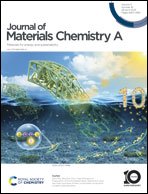Efficiency enhancement of CZTSe solar cells based on in situ K-doped precursor†
Abstract
An in situ potassium (K)-doped copper–zinc–tin–sulfide (CZTS) precursor is prepared and annealed through selenization. After comprehensive optimization of the annealing, a cell with an efficiency of up to 12.62% is obtained, far exceeding the 10.32% efficiency of the reference cell. Besides excellent grain growth enhancement due to the K-doping, the removal of voids in the bulk of the absorber is confirmed. A model based on in situ K-doping-enhanced element diffusion is proposed to explain this effect, showing the validity and universality of the proposed method. Moreover, the suppression of the deep-level defect states is confirmed by the elimination of the ‘roll-over’ behavior and greatly enhanced photoluminescence intensity. Temperature-dependent admittance spectroscopy is applied to the fabricated device, enabling the defect types to be determined. This study sheds light on the mechanism of defect modification through K-doping via the in situ incorporation strategy which prevents the disturbance caused by initial K diffusion in other ex situ incorporation strategies. Based on the results, the defect modification of in situ K-doping is attributed to the doping-induced homogenization of matter, which suppresses the Sn-related defects (e.g., ZnSn, VSn) stemming from local composition vibration.



 Please wait while we load your content...
Please wait while we load your content...